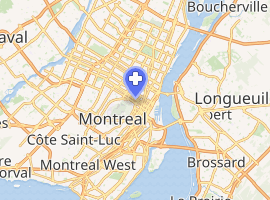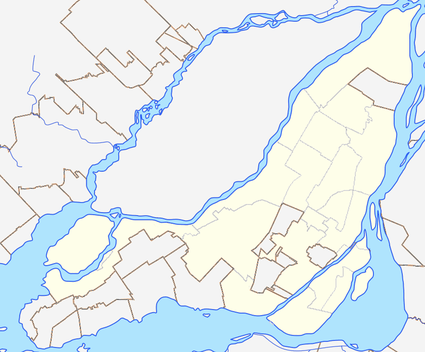Hôtel-Dieu de Montréal
The Hôtel-Dieu de Montréal (founded in 1645) is the first hospital established in Montreal, Quebec, Canada.[1] Since 1996 it has been one of the three hospitals making up the Centre hospitalier de l'Université de Montréal (CHUM).
| Hôtel-Dieu de Montréal | |
|---|---|
| Centre hospitalier de l'Université de Montréal | |

| |
 Location in Montreal | |
| Geography | |
| Location | 3840, rue Saint-Urbain Montreal, Quebec, Canada H2W 1T8 |
| Coordinates | 45.514587°N 73.578937°W |
| Organisation | |
| Care system | RAMQ (Quebec medicare) |
| Type | Teaching |
| Affiliated university | Faculté de médecine - Université de Montréal |
| Services | |
| Emergency department | N/A |
| History | |
| Opened | 1659 |
| Links | |
| Website | http://www.chumontreal.qc.ca |
Hôtel-dieu, literally translated in English as Hotel of God, is an archaic French term for hospital, referring to the origins of hospitals as religious institutions.
History
The origins of the Hôtel-Dieu de Montréal date to the arrival in 1642 of Paul Chomedey and a small party of French settlers on the Island of Montreal to found the French colony of Ville-Marie. Among them was Jeanne Mance, the first nurse in New France. She founded the hospital on October 8, 1645, as confirmed by letters patent of Louis XIV of France in April 1669.[2]
In addition to returning to France to seek financial support for the hospital, in 1657 Mance recruited three sisters of the Religious Hospitallers of St. Joseph (Religieuses hospitalières de Saint-Joseph) order of nuns to serve with her as staff. Their order was founded in 1636 by a layman, Jérôme Le Royer de la Dauversière, along with Mother Marie de la Fere (fr), in La Fleche, France. Guillaume Bailly, a Sulpician missionary, is credited with drawing up the plans for the stone structure that was built in 1688.
The hospital burned and was rebuilt three times between 1695 and 1734. After the conquest of New France by the British, for two centuries, it was the only French-language hospital in Montreal. Around 1850, the hospital became affiliated with the Montreal School of Medicine and Surgery. It continued to grow until 1861, when it was moved from Old Montreal to its present site near Mount Royal. It had an affiliated nursing school between 1901 and 1970.
In 1996, it became one of the three hospitals to make up the Centre hospitalier de l'Université de Montréal (CHUM), along with the Hôpital Notre-Dame du CHUM and the Hôpital Saint-Luc du CHUM. With the completion of the CHUM megahospital campus adjacent to Hôpital Saint-Luc in 2017, the Hôtel-Dieu's patients were to move to the new facility as of November 5, 2017. The Hôtel-Dieu was initially slated for closure, but will ultimately remain open as a large-scale urgent care clinic.
The present site contains a museum of the hospital's long history.
Medical achievements
During its history, many medical milestones have been recorded at the Hôtel-Dieu, including the world's first removal of a kidney (1868), the world's first removal of a tongue and jaw (1872), the first femur transplant (1959), the first identification of an AIDS patient in Canada (1979), the world's first successful recovery of a person with severe burns to 90% of the body (1981), and the world's first robotically assisted laparoscopic surgery (1993).

References
- Bates, Christina; Dodd, Dianne; Rousseau, Nicole (April 30, 2005). On All Frontiers: Four Centuries of Canadian Nursing. University of Ottawa Press. p. 57. ISBN 9780776605913. Retrieved October 7, 2012.
- Buescher, John. "Religious Orders of Women in New France", Teaching history website, accessed August 21, 2011
Further reading
- Joanna Emery, "Angel of the Colony," Beaver (Aug/Sep 2006) 86#4 pp 37–41. online
